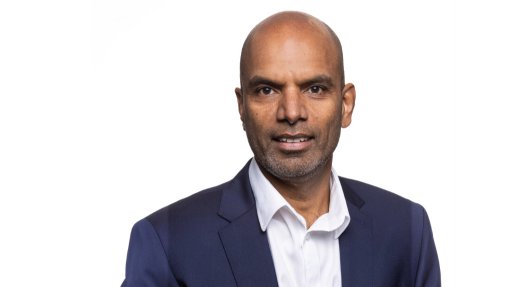S Africa needs electricity intervention now



SAMPSON MAMPWHELI By reintroducing energy efficiency and demand-side management programmes, the country can reduce pressure on the grid within six to eight months
MORE INCENTIVE NEEDED A rebate scheme should also be introduced to encourage South African homeowners to replace their electric geysers with solar water heater technology, heat pumps or gas geysers
South Africa needs to promptly implement small interventions to ease the pressure on the national electricity grid, requiring an investment of between R50-billion and R100-billion, while longer-term initiatives to stabilise the power system are rolled out, says Stellenbosch University Faculty of Engineering Centre for Renewable and Sustainable Energy Studies director Professor Sampson Mampwheli.
“Eskom implemented a successful energy efficiency and demand-side management programme between 2008 and 2011. By reintroducing the energy efficiency and demand-side management programmes following government’s declaration of a national power emergency, the country can reduce pressure on the grid within six to eight months as it waits for new generation capacity to come online.”
He says the current management of State-owned power utility Eskom is dealing with ageing, neglected infrastructure, sabotage, ongoing theft and fraud and, while it has the capacity to solve the country’s energy crisis, the utility cannot solve the biggest issue – getting new-generation capacity online as quickly as possible – alone.
“This is reliant on the competency of the Department of Mineral Resources and Energy, and government holistically. Government has put various interventions in place to address the country’s lack of generation capacity, but this has mainly been focused on the long term.”
Government has allowed municipalities to buy power directly from independent power producers (IPP), streamlined Eskom’s wheeling and banking of energy, and offset arrangements and the procurement of further generation capacity through the Renewable Energy IPP Procurement Programme with the announcement of Bid Window 6 last month.
A 20-year power purchase agreement has also been signed with Norweigan renewable power producer Scatec, which is set to develop a R16.4-billion solar-battery project in the Northern Cape, under government’s Risk Mitigation IPP Procurement Programme.
However, there has been criticism about Scatec’s Kenhardt projects being the only ones under that programme to have progressed to financial close, Engineering News reported last month.
Eskom’s unbundling, which is expected to be concluded by December, has also been implemented to “enable a competitive market for electricity generation and the establishment of an independent State-owned transmission company”, said President Cyril Ramaphosa in February.
“But all these interventions will start having an impact only in the next two to three years, whereas the country needs solutions that relieve the pressure on the national power grid in the next three to six months,” Mamphweli emphasises.
Is Help on the Way?
Encouragingly, Ramaphosa announced an action plan to end load-shedding last month.
The interventions include lifting the 100 MW licence-exemption cap altogether on distributed generation plants being developed by miners and heavy industry.
Following the initial lifting of the licensing exemption threshold under Schedule 2 of the Electricity Regulation Act being lifted to 100 MW in June last year, The National Energy Regulator of South Africa has registered up to 1 400 MW, states Mamphweli.
Ramaphosa noted that the reform had already stimulated 80 confirmed private- sector projects with a combined capacity of more than 6 000 MW.
Eskom will also pursue the roll-out of energy efficiency retrofits to reduce demand on the grid, as well as demand management solutions, which could lower or shift demand by as much as 600 MW, particularly over peak periods.
Ramaphosa further aims to encourage investments in commercial and residential solar rooftop systems by creating a feed-in tariff.
Additional interventions include boosting the recruitment of skilled workers at Eskom and addressing sabotage and theft at the utility, while also improving logistics to ensure that diesel-fired turbines are supplied in a timely fashion. Eskom will also be allowed to buy excess power from private producers and import more power from countries in the region, including Botswana and Zambia. Local content requirements for projects awarded in Bid Window 5 will also be eased in addition to boosting the size of Bid Window 6 and expediting further rounds.
A plan to deal with Eskom’s debt will also be announced before October.
Mamphweli supports Ramaphosa’s plan, stating that the immediate solution to reducing the pressure on the grid includes rolling out remote geyser control systems, whereby Eskom can inform users when to reduce their load on the system.
A rebate scheme should also be introduced to encourage South African homeowners to replace their electric geysers with solar water heater technology, heat pumps or gas geysers.
“We can quickly roll out such initiatives, the expense of which is a drop in the ocean, compared with what load-shedding is costing the South African economy. We already have a list of approved suppliers from when Eskom ran a heat pump rebate programme in the past.”
Such energy efficiency and demand-side management initiatives previously implemented by the utility, combined with economic contraction, are why South Africa did not experience load-shedding in 2015, says Mamphweli.
Article Enquiry
Email Article
Save Article
Feedback
To advertise email advertising@creamermedia.co.za or click here
Comments
Announcements
What's On
Subscribe to improve your user experience...
Option 1 (equivalent of R125 a month):
Receive a weekly copy of Creamer Media's Engineering News & Mining Weekly magazine
(print copy for those in South Africa and e-magazine for those outside of South Africa)
Receive daily email newsletters
Access to full search results
Access archive of magazine back copies
Access to Projects in Progress
Access to ONE Research Report of your choice in PDF format
Option 2 (equivalent of R375 a month):
All benefits from Option 1
PLUS
Access to Creamer Media's Research Channel Africa for ALL Research Reports, in PDF format, on various industrial and mining sectors
including Electricity; Water; Energy Transition; Hydrogen; Roads, Rail and Ports; Coal; Gold; Platinum; Battery Metals; etc.
Already a subscriber?
Forgotten your password?
Receive weekly copy of Creamer Media's Engineering News & Mining Weekly magazine (print copy for those in South Africa and e-magazine for those outside of South Africa)
➕
Recieve daily email newsletters
➕
Access to full search results
➕
Access archive of magazine back copies
➕
Access to Projects in Progress
➕
Access to ONE Research Report of your choice in PDF format
RESEARCH CHANNEL AFRICA
R4500 (equivalent of R375 a month)
SUBSCRIBEAll benefits from Option 1
➕
Access to Creamer Media's Research Channel Africa for ALL Research Reports on various industrial and mining sectors, in PDF format, including on:
Electricity
➕
Water
➕
Energy Transition
➕
Hydrogen
➕
Roads, Rail and Ports
➕
Coal
➕
Gold
➕
Platinum
➕
Battery Metals
➕
etc.
Receive all benefits from Option 1 or Option 2 delivered to numerous people at your company
➕
Multiple User names and Passwords for simultaneous log-ins
➕
Intranet integration access to all in your organisation




















